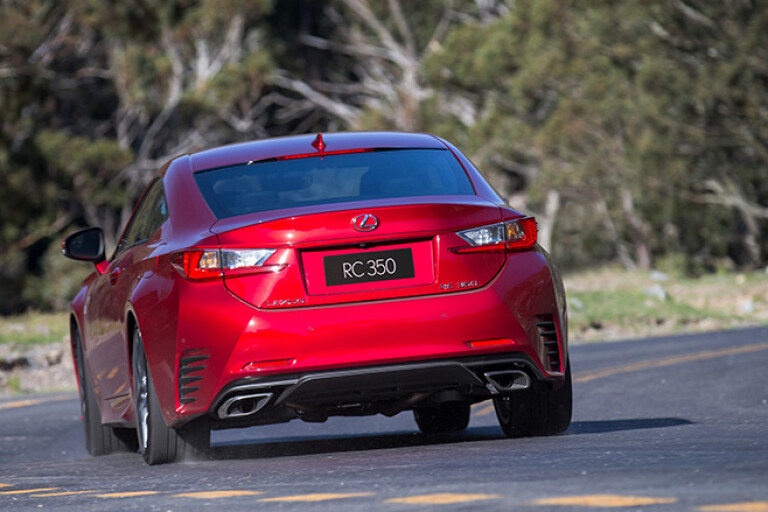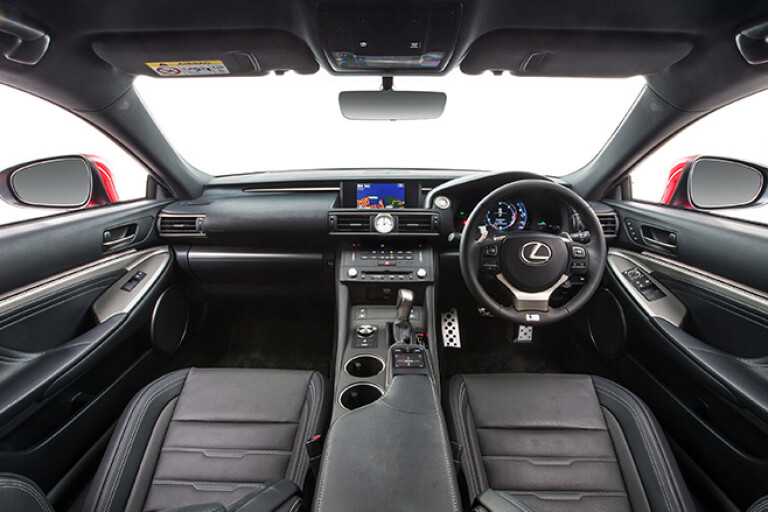
What is it?
Lexus calls the RC “the most emotional vehicle we’ve made since the LFA”, and they’re hoping it’ll change perceptions of the brand a little – bring a little bit of excitement back into the showroom. And it will – it’s a good looking car in the metal, and perhaps the first time that Lexus spindle grille really looks natural, and not like an uncomfortable obligation.
What’s it all about?
It’s a sports coupe that’s been designed as a coupe from the very beginning, unlike most other coupes, which are rejigged versions of their four-door siblings. The RC has an all-new chassis – and by ‘all new’, they mean ‘Frankensteined together from existing platforms.’ Which is, of course, the modular future for all car-makers, but there’s still something oddball about this car with the front underpinnings from a GS, the middle of the old IS convertible and the rear of the new IS.
Lexus also offer the RC F with a stonking V8, but in the RC 350, it’s V6 all the way: a 3.5-litre unit that delivers a handy if not spectacular level of punch, 233kW at 6400rpm and 378Nm at 4800rpm, good for a nought to 100km/h sprint of 6.1 seconds. And good news for fans of naturally-aspirated rear-wheel-drive cars: while it feels like the whole world has gone turbo, the RC 350 is still joyously atmo.

What’s it cost, and is it worth the money?
There are three variants, starting with the Luxury. There’s something admirably bullish about calling your entry level variant ‘Luxury’. Then comes the F Sport, and top-spec Sport Luxury.
The entry price of $66,000 for the Luxury will turn heads. The F Sport is $74k, and then the Sport Luxury is $86k. Lexus admits the RC 350 is “priced to disrupt.” And it might well disrupt a few customers away from a BMW 4 Series or Audi A5, which would cost you tens of thousands more to get a similar power output – and even then, you’d have to pay more again to match the Lexus on spec.
But it’s not exactly a like-for-like comparison. For one thing, the BMW 435i (225kW, 400Nm) is a full second quicker from 0-100, and a fair bit more frugal on the juice (7.4L/100km for the Beemer, compared with 9.4L for the RC 350); it’s a similar story with the Audi A5. The reason is, that the Lexus is a bit of a porker: a kerb weight of 1,680kg up to 1,740kg, depending on the variant, which is more than 220kg more than the 435i.
Partially that’s because of the thickness of the floor panels and the sandwich sheet steel that make the RC 350 so quiet and refined around town and on the freeway.

What’s it like to drive fast?
You can feel that weight when you get the Lexus onto some winding rural roads. Through dips and around corners, there’s a real sense of more mass than in a 4 Series. And while the RC 350 isn’t exactly short on power, on uphill overtakes even on fairly mild inclines, it takes a moment or two for the big beast to get moving, especially if the engine’s not already at peak torque (which doesn’t arrive ‘til 4,800rpm). That’s particularly true of the entry level Luxury model; in the F Sport (which Lexus estimates will account for the lion’s share of sales), you can put it in Sport Plus mode, which does sharpen things up when you goose the accelerator.
The F Sport also gets adaptive variable suspension and dynamic rear steer: the rear wheels turn just slightly opposite to the front wheels under 80km/h, which effectively reduces the wheelbase; but they turn with the front wheels above 80km/h, to increase stability.
To test the difference, we took first an entry level Luxury (sans rear steer) and then an F Sport for a slalom blat through some cones in a wet carpark. In ‘Normal’ mode, there was perhaps a minor difference – or perhaps it was just a placebo effect – but in Sports Plus mode, there is a massive difference: the F Sport hooks into sharp turns harder, and the adaptive suspension keeps the car balanced even as you fling it from side to side.

What’s it like inside?
Inside, the RC 350 is a bit of a mixed bag. It’s very a quiet and refined ride – brilliantly quiet, actually – but the cabin is an acquired taste. There’s a slightly weird layout – not bad, exactly, just weird, all jutting ledges and clashing surfaces. And some of the materials feel a bit cheapish – some hard plastics and crappy digital readouts that don’t feel worthy of something called Luxury. On the other hand, there is a huge and prominent CD player, which will be good news if you’ve just awoken from a coma since 1998.
And, be warned if you’re over six foot: it’s not the roomiest cabin I’ve ever sat in. At 6’2”, I had to angle the seat well back to keep my head off the ceiling. And the rear seat is really more of a 2+2 proposition.
Would you take this or a BMW 4 Series?
The 435i is a better car – but is it $42,000 better? To get comparable performance and specs to the entry RC 350 Luxury, you have to go for the top-shelf 4 Series (excluding the M4) – and the Lexus costs just two-thirds as much. So you’d really have to ask yourself, how often are you going to be really driving at ten-tenths? If you’re a dedicated track-day driver, or real-life Fast & Furious street racer, the Beemer is the better choice. If you’re just looking for an up-market sports coupe with some go-fast potential when you need it, the Lexus is a rational choice.
COMMENTS